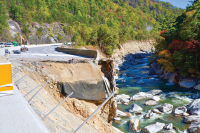LWCF has been a great resource for this country
When most of us here in Western North Carolina go for a hike on the Appalachian Trail, hunt or fish in the national forest, enjoy a scenic drive along the Blue Ridge Parkway, or visit the Carl Sandburg Home, we do not normally stop to think about how such opportunities were created or paid for.
Much of our national forest land here in North Carolina was acquired in the early twentieth century in order to restore forests and watersheds damaged by unregulated logging. But during the decade of suburban expansion that followed World War II, it quickly became apparent that land was a finite resource and further action was necessary to preserve our best wild places. On Valentine’s Day in 1963, President John F. Kennedy proposed legislation that would become the Land and Water Conservation Fund (LWCF) in September of that year.
There was strong bi-partisan support for the bill and its passage established a fund that received about $100 million a year during the 1960s, an amount that was quickly determined to be inadequate. Growing demands on the LWCF led to Congress eventually tapping funds paid to the government by big oil and gas companies for offshore oil and mineral leases.
In 1977, Congress authorized the LWCF to receive $900 million per year, and the actual allocation reached an all-time high of $805 million the following year. After that, Congress simply used much of the oil and gas lease revenues for other purposes, instead of putting it into the LWCF where it belonged. The fund has been on a roller coaster of ups and downs since its high in 1978, with mostly down years — for fiscal year 2007 the fund stood at $141 million in funding. From 2002 to 2006, officials cut funding more than 75 percent.
This extremely important source of funding has protected a total of 4.7 million acres since its inception, including tens of thousands of acres to create and protect the Appalachian Trail, stretching from Maine to Georgia. Here in North Carolina, it has provided more than $63 million in funding for the protection of more than 37,000 acres and more than 800 state and local park projects.
Most recently, the LWCF provided $4 million in 2001 for a key 3,000-acre addition to Lake James State Park, as well as over half a million dollars for the creation of Blair Point Park in Morehead City. Blair Point Park was funded through the LWCF’s state matching grant program, often referred to as the “stateside” program, that provides federal funds to states and localities to assist in the planning and acquisition of open space such as greenways and local recreation facilities.
However, for 2008, the president’s budget includes a meager $59 million for the LWCF nationwide and eliminates the stateside grant program altogether. For perspective, the state of North Carolina’s recent purchase of the 996- acre Chimney Rock Park in Rutherford County came with a price of $24 million.
Perhaps most startling is that the administration’s budget recommendations include no funding whatsoever for projects in our region. It also calls for a massive sell off of 300,000 acres of national forest lands and 500,000 acres of Bureau of Land Management lands. This includes 5,685 acres of national forest land in North Carolina with the vast majority of it lying within the Nantahala and Pisgah national forests. This situation cannot be ignored given that we live in one of the fastest- growing regions in the nation and that the U.S. has lost more than six million acres to development between 1982 and 1997, according to forest service statistics. And that loss is not slowing down — 250 football fields of open space and forests disappear every hour across America.
The forest service in our region has identified key tracts for land conservation, mainly along the Appalachian Trail, but needs over $7 million dollars from the LWCF in order to acquire them from willing sellers. These areas include a key parcel in Western North Carolina on Wesser Bald, as well as a portion of the 10,000-acre Rocky Fork tract in Tennessee, which runs along the Western North Carolina border near the Roan Highlands.
The Rocky Fork tract is one of the largest unprotected tracts left in the southern Appalachian Mountains. In addition to being adjacent to the Appalachian Trail, it is adjacent to more than 22,000 acres of wilderness and potential wilderness lands protected by the forest service in North Carolina and Tennessee. Although it is being marketed for second- and primary-home development, the owner has shown an interest in protecting the property and is currently working with several conservation organizations to see if that can be achieved.
Priorities also include several parcels in north Georgia, Tennessee, and Virginia that will protect public access to the Appalachian Trail and protect water quality. Given the rising cost of real estate across the region, the window of opportunity for such acquisitions will soon slam shut. The Senate Appropriations Committee approved more than $3 million from the LWCF for the acquisition of the Rocky Fork tract and $1 million for north Georgia, but that is only half of what is needed this year to acquire Rocky Fork and doesn’t include the forest service’s other priorities for protection in the region.
Please write Senators Dole and Burr, along with Congressman Heath Shuler , and ask them to support funding to protect Rocky Fork and the Appalachian Trail projects in our region, along with the full funding of the LWCF. And while you’re at it, remind them that the national forests in our region are not for sale.
(Brent Martin runs the North Carolina office for The Wilderness Society in Franklin. He can be reached at This email address is being protected from spambots. You need JavaScript enabled to view it..)





